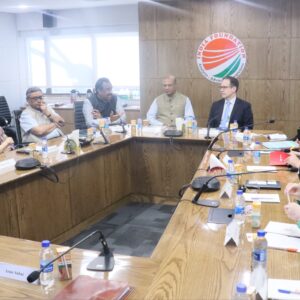Atenacious boundary dispute, large volumes of trade, boundary incursions, similar stances on advancing developing countries’ interests with respect to climate change, a persistent trade deficit, mutual suspicion, a boundary skirmish in 1962 and growth rates high enough to herald what is known as the Asian century! A strange mix of these facts and more is what India-China relations have been. An emphasis on cooperation is the overarching framework of the bilateral relations between India and China, and an emphasis on mutual benefits is a constant in official statements from the two sides. Even post the standoff at Doklam last year, Chinese foreign minister Wang Yi told a news briefing that it was normal for the two neighbours to have differences. He added that there is a huge potential for cooperation between the two countries. In fact, despite 2017 having been marred by the Doklam standoff, a milestone in cooperation was achieved in June, at the Astana summit of the Shanghai Cooperation Organization, when India became a full member of the organization.
However, despite the seeming bonhomie between the two, bilateral relations between the two in reality remain a strange mix of cooperation and conflict. Beyond the boundary dispute, a persisting negative balance of trade for India is an irritant in the relations. In a span of ten years, the growth in trade deficit between India and China has been 319.74 percent! While the uncovered trade gap was USD 602 millions in 1998, it increased to USD 48 billion in 2015. Trade deficit with China narrowed only marginally to USD 51.08 billion in 2017 from USD 52.69 billion in 2016.
India’s export basket to China is dominated by commodities like cotton, copper, cement and mineral fuels; while China’s top exports to India include electrical items, organic chemicals, plastics and ships among others. In the unfolding scenario of the ‘new normal’ in China, the process of the commodities that forms India’s export basket to China is likely to remain subdued. In a situation of the new normal, where China has to spur its own domestic consumption, import reduction is not unimaginable, and India is likely to see its trade deficit with China rising in the near future.
The simplest solution to address the trade deficit would be to increase the availability of Indian goods in the Chinese market. However, India lacks a comparative advantage in producing goods, whereas China is the manufacturing platform of the world. Even in the goods that India does have a comparative advantage, pharma-ceuticals for example, there exists tariff as well as non tariff barriers in China. While licenses and regulations for Chinese Application Programming Interfaces (APIs) are granted by Indian Drug Regulatory Authorities in four months, it takes roughly five to six years for even established Indian Pharma firms to register their products in China. Indian IT services are unable to make a massive breakthrough in China’s opaque state controlled and state owned enterprises.
The reason for Indian products being at the receiving end of non tariff barriers is clearly political. An example of this lies in the case of Basmati rice. China in one of the largest buyers of non-Basmati rice from Pakistan, but it does not allow such supplies from India. Certain oilseed exports require as many as 11 certificates stating the items are pest free. Ironically, 10 of the 11 pests mentioned are already present in China.
Additional issues include those of banking and foreign exchange remittance procedures, lack of intellectual property standards and a lack of transparency. Implementation of rules is different at national and sub national levels in China, the details of which are not easily available in English. Additionally, there have been instances, wherein factories are inspected at the exporter’s expense. Such forms of restrictions on imports by stealth, through the usage of non tariff barriers, often remain invisible.
Another plausible way to address the trade deficit is through increasing levels of Chinese foreign direct investment (FDI) in India. However, Chinese FDI is negligent in India as compared to FDI received from other countries. India received USD 60 billion worth of FDI in 2016-17, of which only USD 278 million came from China.
A third way to tackle the issue is through addressing the problem of dumping. The government of India has already started taking steps in this regard. In October 2017, to protect local steel manufacturers from cheap imports, India imposed anti dumping duties on stainless steel products from certain countries including China. Last year, India launched 12 anti dumping investigations against China, followed by the U.S. with 11 investigations. China suffered 37 trade remedy investigations in all last year. The issue of dumping is a source of concern not just for India but for other countries as well. In December last year, the G 20 body called the Global Forum on Steel Excess Capacity reached a deal which promises that countries will phase out subsidies and cut over capacities- a move aimed particularly at China. The deal was struck despite the US, which is the world’s largest importer of steel and China, the world’s largest exporter of steel being at loggerheads. China resisted US pressures to take on more responsibilities for market distorting trade.
Keeping the slowing Chinese economy in mind, the already shrinking demand in China for raw materials will only shrink further, resulting in huge overcapacities. This in turn will force producers to increasingly push sales to the rest of the world, often at much below realistic prices. This will be a big source of concern for countries like India which already are at the receiving end in the bilateral trade relationship.
As seen from the trade patterns and the history of lingering trade deficit, as well as the existence of tariff and non tariff barriers, China has not opened many doors to Indian products. The state of economic relations between the two clearly is not a win-win one. For India, there is an urgent need to change the trade basket and to introduce elements wherein India has proven competence. Additionally the tools provided by multilateral institutions such as the Global Forum on Steel Excess capacity is an innovative tool to address trade distorting practices, and India needs to utilize more of such tools. In addition, India needs to repeat emphasis on market access and removal of tariff and non tariff barriers during talks. India could also encourage its traders to showcase their products at trade fairs in China, in order to create greater demand for the goods. Given the fact that India is among the biggest markets for smart phones and other electronic goods, the demand for Chinese goods is going to remain constant. However, India could look at sourcing of electronic goods from China to Taiwan. A trade deficit as huge as USD 51.08 billion in clearly not sustainable and will only weaken the fundamentals of the Indian economy.
(Dr. Sriparna Pathak is an Assistant Professor at the School of Humanities and
Social Sciences at Assam Don Bosco University, Tapesia Campus, Guwahati, Assam.)
(This article is carried in the print edition of March-April 2018 issue of India Foundation Journal.)




So very proud of you Sriparna!! God bless